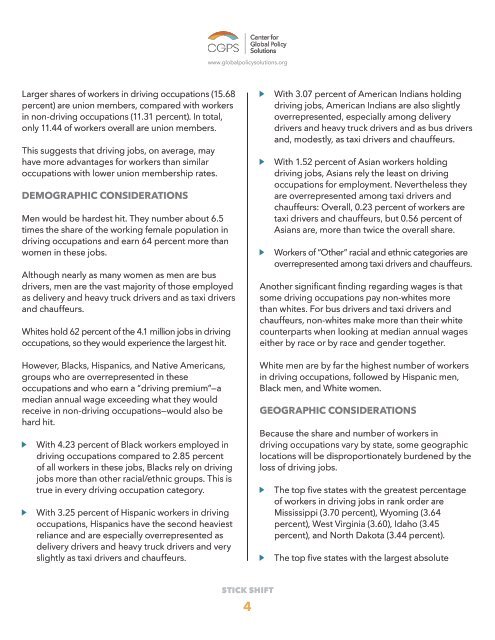STICK SHIFT
Stick-Shift-Autonomous-Vehicles
Stick-Shift-Autonomous-Vehicles
Create successful ePaper yourself
Turn your PDF publications into a flip-book with our unique Google optimized e-Paper software.
www.globalpolicysolutions.org<br />
Larger shares of workers in driving occupations (15.68<br />
percent) are union members, compared with workers<br />
in non-driving occupations (11.31 percent). In total,<br />
only 11.44 of workers overall are union members.<br />
This suggests that driving jobs, on average, may<br />
have more advantages for workers than similar<br />
occupations with lower union membership rates.<br />
DEMOGRAPHIC CONSIDERATIONS<br />
Men would be hardest hit. They number about 6.5<br />
times the share of the working female population in<br />
driving occupations and earn 64 percent more than<br />
women in these jobs.<br />
Although nearly as many women as men are bus<br />
drivers, men are the vast majority of those employed<br />
as delivery and heavy truck drivers and as taxi drivers<br />
and chauffeurs.<br />
Whites hold 62 percent of the 4.1 million jobs in driving<br />
occupations, so they would experience the largest hit.<br />
However, Blacks, Hispanics, and Native Americans,<br />
groups who are overrepresented in these<br />
occupations and who earn a “driving premium”—a<br />
median annual wage exceeding what they would<br />
receive in non-driving occupations—would also be<br />
hard hit.<br />
With 4.23 percent of Black workers employed in<br />
driving occupations compared to 2.85 percent<br />
of all workers in these jobs, Blacks rely on driving<br />
jobs more than other racial/ethnic groups. This is<br />
true in every driving occupation category.<br />
With 3.25 percent of Hispanic workers in driving<br />
occupations, Hispanics have the second heaviest<br />
reliance and are especially overrepresented as<br />
delivery drivers and heavy truck drivers and very<br />
slightly as taxi drivers and chauffeurs.<br />
With 3.07 percent of American Indians holding<br />
driving jobs, American Indians are also slightly<br />
overrepresented, especially among delivery<br />
drivers and heavy truck drivers and as bus drivers<br />
and, modestly, as taxi drivers and chauffeurs.<br />
With 1.52 percent of Asian workers holding<br />
driving jobs, Asians rely the least on driving<br />
occupations for employment. Nevertheless they<br />
are overrepresented among taxi drivers and<br />
chauffeurs: Overall, 0.23 percent of workers are<br />
taxi drivers and chauffeurs, but 0.56 percent of<br />
Asians are, more than twice the overall share.<br />
Workers of “Other” racial and ethnic categories are<br />
overrepresented among taxi drivers and chauffeurs.<br />
Another significant finding regarding wages is that<br />
some driving occupations pay non-whites more<br />
than whites. For bus drivers and taxi drivers and<br />
chauffeurs, non-whites make more than their white<br />
counterparts when looking at median annual wages<br />
either by race or by race and gender together.<br />
White men are by far the highest number of workers<br />
in driving occupations, followed by Hispanic men,<br />
Black men, and White women.<br />
GEOGRAPHIC CONSIDERATIONS<br />
Because the share and number of workers in<br />
driving occupations vary by state, some geographic<br />
locations will be disproportionately burdened by the<br />
loss of driving jobs.<br />
The top five states with the greatest percentage<br />
of workers in driving jobs in rank order are<br />
Mississippi (3.70 percent), Wyoming (3.64<br />
percent), West Virginia (3.60), Idaho (3.45<br />
percent), and North Dakota (3.44 percent).<br />
The top five states with the largest absolute<br />
<strong>STICK</strong> <strong>SHIFT</strong><br />
4


